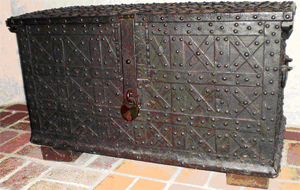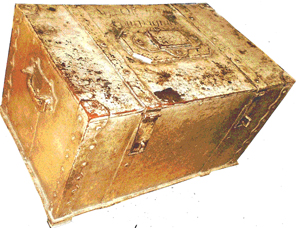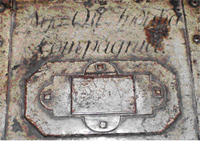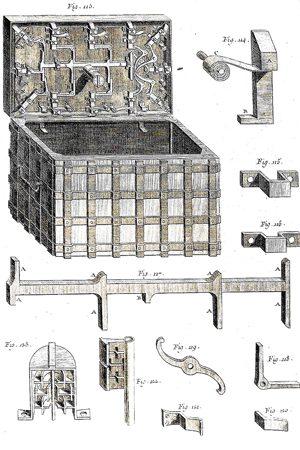During the eighteenth century, iron cash boxes were used throughout northern Europe as storage within fields and contexts in which people handled cash or securities. The design and appearance of this type of chest changed at this time. They became “functional”; in other words, they were adapted to their function to hold large quantities and to prevent forced entry. They lacked almost all ornamentation except the rhythmic pattern of the intersecting strips, as well as some simple embellishment around the keyholes, both the false one and the real one.
 |
| Money chest completely in iron with riveted intersecting fittings and trunk lock (under padlock fitting) plus padlock, dated 1785. Saint Maria Church in Ystad. Photo by the author. |
In Sweden, iron chests were also used onboard the ships of the Swedish East India Company. On its way from Göteborg to Canton in China, the ship carried forging iron that was sold in Cadiz on the west coast of Spain in return for payment with enough silver piasters and silver ingots to fill about 16-17 chests. “The clang of piasters is our music,” wrote Jacob Wallenberg (1776-1778) in the book My Son on the Galley. This is the tale of a ship’s priest on a journey to China with the East-Indiaman Finland. The company owned all of the ships in the fleet and each one had a set of chests.

 |
| An exception from chests with crossed intersecting strips, one of the (New) East India Company’s money chests. Göteborg City Museum. Photo by the author. |

The lock on the lid consists of moveable and fixed parts. The movement of the key bit guides the centrally placed long bolt that transfers the movement via angled actuators to twelve self-closing obliquely beveled lock bolts, each one under the effect of ring-shaped springs. From Duhamel du Monceau, Art du serrurier, Description des arts et métiers, printed in Paris 1767